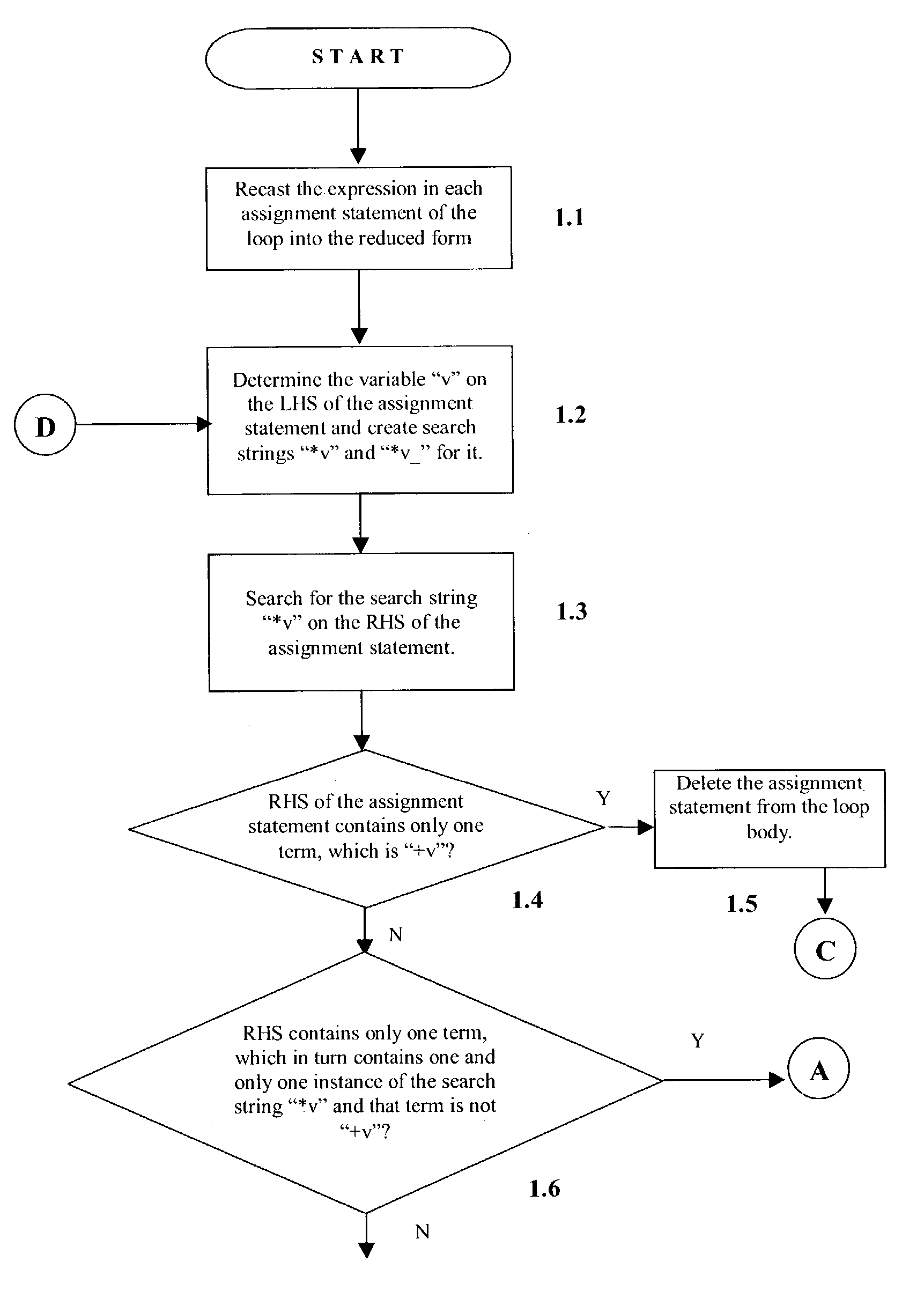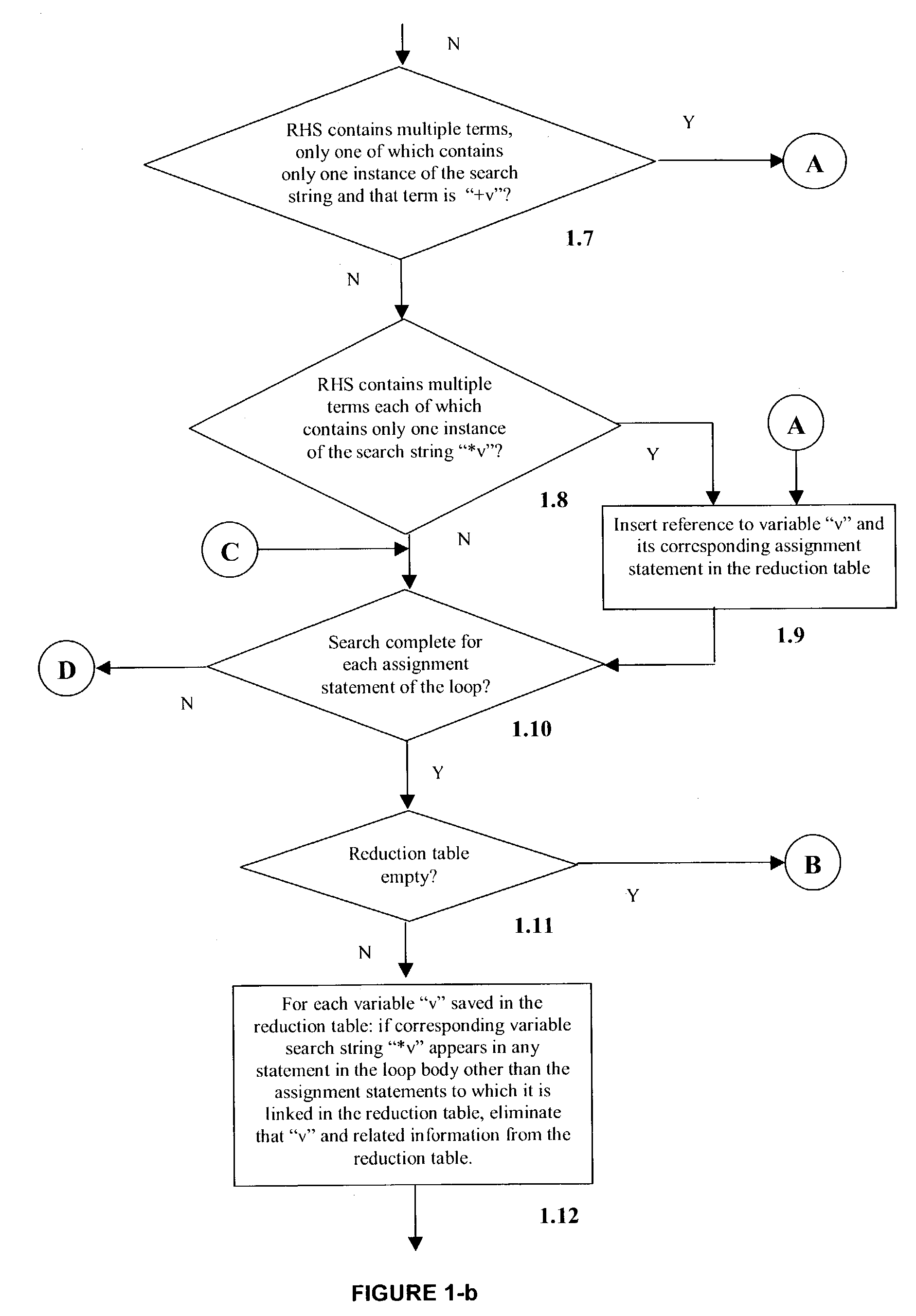Detection of reduction variables in an assignment statement
a technology of assignment statement and reduction variable, applied in the field of assignment statement detection of reduction variable, can solve the problems of not being able to handle all situations efficiently, the reduction parallelization faced by compilers is in recognizing the reduction statement, and the problem has been handled, so as to facilitate the parallelization of the program loop
- Summary
- Abstract
- Description
- Claims
- Application Information
AI Technical Summary
Benefits of technology
Problems solved by technology
Method used
Image
Examples
example 1
[0055]1: do i=1, n[0056]2: x=c*d[0057]3: ai=ai+2.0[0058]4: bi=2.0*bi+(c−d)*bi−bi[0059]5: y=c*y+d*y−3.0*y[0060]6: z=2*a+z−a−a[0061]7: w=w*w / u[0062]8: u=u / w[0063]9: enddo
[0064]After recasting the expressions in each assignment statement of the loop into a reduced form, we have[0065]1: do i=1, n[0066]2: x=+0.100000e+01*c*d[0067]3: ai=+0.200000e+01+0.100000e+01*ai[0068]4: bi=+0.100000e+01*bi+0.100000e+01*bi*c−0.100000e+01*bi*d[0069]5: y=+0.100000e+01*c*y+0.100000e+01*d*y−0.300000e+01*y[0070]6: z=+0.100000e+01*z[0071]7: w=+0.100000e+01*u_*w*w[0072]8: u=+0.100000e+01*u*w—[0073]9: enddo
[0074]After applying the First phase of the algorithm, we note that[0075]x is not a reduction variable since it does not appear on the right hand side,[0076]ai is a potential reduction variable since it appears in only one term which is “+0.100000e+01*ai”,[0077]bi is a potential reduction variable since it appears in all terms and each term has only one instance of “*bi”,[0078]y is a potential reduction vari...
example 2
[0097]1: do i=1, n[0098]2: y=c*y+d*y−3.0*y[0099]3: y=(e*f+g)*y[0100]4: z=z+2[0101]5: z=z*a−b*z[0102]6: enddo
[0103]After recasting the expressions in each assignment statement of the loop into a reduced form, we have[0104]1: do i=1, n[0105]2: y=+0.100000e+01*c*y+0.100000e+01*d*y−0.300000e+01*y[0106]3: y=+0.100000e+01*e*f*y+0.100000e+01*g*y[0107]4: z=+0.200000e+01+0.100000e+01*z[0108]5: z=+0.100000e+01*a*z−0.100000e+01*b*z[0109]6: enddo
[0110]After applying the First phase of the algorithm, we note that[0111]y is a potential reduction variable since it appears in all terms and each term has only one instance of “*y” in statement 2,[0112]y is a potential reduction variable since it appears in all terms and each term has only one instance of “*y” in statement 3,[0113]z is a potential reduction variable since “*z” appears in only one term which is “+0.100000e+01*z” in statement 4,[0114]z is a potential reduction variable since it appears in all terms and each term has only one instance of...
PUM
 Login to View More
Login to View More Abstract
Description
Claims
Application Information
 Login to View More
Login to View More - R&D
- Intellectual Property
- Life Sciences
- Materials
- Tech Scout
- Unparalleled Data Quality
- Higher Quality Content
- 60% Fewer Hallucinations
Browse by: Latest US Patents, China's latest patents, Technical Efficacy Thesaurus, Application Domain, Technology Topic, Popular Technical Reports.
© 2025 PatSnap. All rights reserved.Legal|Privacy policy|Modern Slavery Act Transparency Statement|Sitemap|About US| Contact US: help@patsnap.com



